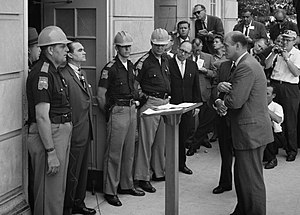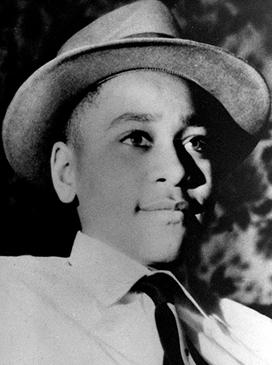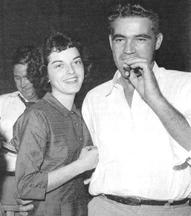Fifty years ago today, at 10:22 am, four little girls were murdered at their church. I'm talking, of course, about the bombing of the 16th Street Baptist Church, in Birmingham. Fifty years removed from all the smoke, rubble, and death, I'm unable to truly reconcile the present reality of the state I was born and raised in with the brutality of its not-so-distant past. I know what happened here, but it seems so far removed now.


Unfortunately, things occasionally happen to remind me that, for many, the viciousness that was expressed so openly fifty years ago has not vanished, but merely hidden itself below the surface. There are bars in this town that still deny entry to blacks, forty-nine years after the Civil Rights Act of 1964 overturned all laws upholding racial segregation. (Last time I checked, money was neither black nor white, but green. But nobody asked me.) The Greek system at Alabama, which is a major part of campus life here, for better or for worse, is currently under intense external scrutiny because it is still almost totally segregated. Recent articles have brought national attention to this practice, and frankly, it's embarrassing. Fifty years ago, in June 1963, Governor George Wallace stood in the door of Foster Auditorium and railed against racial integration until he was forced to move by the National Guard. In hindsight, we made ourselves look like royal jackasses, to put it kindly. But now, even with the gift of hindsight, it seems that we're doing it again.
At work this summer, a little girl in my charge told me she didn't want to go to a particular park because "there are too many black people there." It's not all one-sided, of course: not a week later, three more kids formed a 'club' that didn't allow any whites to join. Racism isn't innate: it's learned, and these kids mimic the attitudes they see present in their parents. So, even though we don't burn crosses anymore, or riot over schools being integrated, we still have a long way to go.
I'm a nostalgic person and I always have been. Whenever I daydream, I inevitably end up in another era: I'm a dancer in a speakeasy, a Resistance fighter in Occupied France, a Southern belle, or a lady of the French Court. One era for which I have no sense of nostalgia is the 1960s. I used to, until I actually learned about it. The '60s were too grim for my tastes, and coming from an historian, that's saying quite a lot. We feed off of grim.
I'm putting away my soapbox now, and turning to the real point of this post. These are four of the forty people honored on the Civil Rights Memorial in Montgomery. Some were world-famous leaders, others were activists, quiet but defiant, still others were just doing their jobs, some were in the wrong place at the wrong time, and others were just children. They are a diverse group: black and white, male and female, old and young. Not all of them are even American. Their only common bond: their deaths were the result of and catalysts for the Civil Rights Movement.

George W Lee was born in Mississippi in 1903. He became a preacher and opened a successful grocery store and printing shop in Belzoni, Miss. He was the first black in the county to register to vote, he co-founded the local NAACP branch, took the sheriff to court when his poll tax was refused, registered almost ninety black voters in his county, and in April 1955 drew over 7000 to hear him speak. He was offered protection from white officials, on the condition that he cease his political activities and remove his name from the voter roll. Lee refused. About a month later, late on the night of 7 May, a convertible pulled up alongside his car and the driver fired buckshot into Lee's car window. His face was mutilated and his jaw shattered. He died before he made it to hospital. The sheriff claimed the buckshot pellets were actually fillings knocked loose in a one-vehicle accident. No one was ever arrested.
_________________________________________________________________

Lamar Smith was born in 1892. He was a farmer and veteran of the First World War. He frequently attended Civil Rights meetings and registered blacks to vote in Lincoln County, Miss. On 15 Aug 1955, Smith was shot to death at close range, in broad daylight, on the courthouse lawn. According to contemporary accounts, over a dozen witnesses were present, including the sheriff. Three men were arrested, but acquitted for lack of witness testimony.
_________________________________________________________________

Emmett Till was born in 1941. He was raised by his mother Mamie, who was separated from her abusive husband. Emmett had contracted polio at the age of six and spoke with a pronounced stutter. He was, by most accounts, a happy, outgoing, and popular kid. He liked to get dressed up, play sports, and play pranks. Fiercely loyal to his mother, he once pulled a butcher knife on her estranged second husband, who was threatening her, to make him leave. He was fairly stoutly built, standing 5'4" and weighing almost 150 pounds. He was murdered in August 1955, just a month after his fourteenth birthday. From Chicago, Emmett was visiting family in Money, Mississippi. While at a small grocery store, he reportedly acted like a fourteen-year-old boy, flirting with the 21-year-old proprietress. Her name Carolyn Bryant. She was married. And white.
 |
| Carolyn and Roy Bryant, image: Univ of MO- Kansas City |
| J.W. Milam, image: UMKC |

When his body was found it was recognizable only by the ring he was wearing: the initials 'L.T.,' for 'Louis Till,' Emmett's father, were engraved on it. The difficulty in obtaining a positive identification put those seeking justice for Till at an even greater disadvantage. Emmett's mother Mamie made the decision to give Emmett an open casket funeral. The images from the funeral are literally sickening, and were picked up by magazines and newspapers. White Mississippians were not exempt from the horror of the crime. Rather than siding with the Bryants, many decried them as the type of white trash that would be the ruin of Mississippi. However, opinions soon shifted again, this time in favor of the killers. Though Bryant and Milam initially had trouble finding lawyers to represent them, a firm in the town of Sumner, where the trial was held, agreed to represent them pro bono. Collection jars placed around town raised 10,000 dollars for their defense.
The trial was in September, and lasted for five days. Like any stereotypical Southern courtroom, it was apparently very hot. Two black men who worked for Milam were mentioned as witnesses, but were brought up on bogus charges and held in another town to keep them from testifying at the trial. The most dramatic moment of the trial, according to most of the reporters present, was when Till's uncle, Mose Wright, stood up and identified Emmett's murderers. Though photography was prohibited in the courtroom, one intrepid journalist ignored that, and snapped a fantastic picture. It was a first in Mississippi; no black had ever stood in a court of law and directly accused a white of murder. Apparently, this happened in response to the defense attorney claiming Wright could not identify the killers. At this, he stood and pointing to Milam, said: "Thar' he."

Though two of the witnesses couldn't be found (as they were being held prisoner), three more surfaced, two of whom testified. One testified that he heard Emmett begging for mercy as he was being beaten. The defense consisted almost entirely of the claim that the body was too badly decomposed to identify. They raised the (ridiculous) possibility that the corpse was planted by the NAACP to stir up trouble. The real Emmett Till was back safe in Chicago. To the surprise of almost no one, the all-white, all-male jury acquitted Bryant and Milam. It took them sixty-seven minutes. One observer remarked that the prosecution made a mistake in dismissing any potential juror who knew the defendants, as most people who knew the men disliked them intensely. One juror voted twice to convict them, but was persuaded to change his mind for the third vote. Later, many juror admitted they knew Bryant and Milam were guilty. However, they thought the two possible punishments (death or life in prison) were too harsh for the crime of killing a black man. Two other jurors later claimed that they considered the defense's claims of a conspiracy to be reasonable doubt. For related reading and some interesting photographs, this article from The New York Times Magazine is fascinating. The witnesses were all relocated for their own safety. The next year, a grand jury refused to indict Bryant and Milam for kidnapping.
However, smug bastards that they were and protected from double jeopardy, Bryant and Milam granted an interview to Look magazine in 1956. They blatantly admitted to killing the fourteen-year-old. All the support they had won for themselves vanished. Local blacks, who made up almost all of their customer base, boycotted their stores, forcing them into bankruptcy. Banks refused to lend them any money. In his own words, Milam described the murder in Look:
Well, what else could we do? He was hopeless. I'm no bully; I never hurt a nigger in my life. I like niggers—in their place—I know how to work 'em. But I just decided it was time a few people got put on notice. As long as I live and can do anything about it, niggers are gonna stay in their place. Niggers ain't gonna vote where I live. If they did, they'd control the government. They ain't gonna go to school with my kids. And when a nigger gets close to mentioning sex with a white woman, he's tired o' livin'. I'm likely to kill him. Me and my folks fought for this country, and we got some rights. I stood there in that shed and listened to that nigger throw that poison at me, and I just made up my mind. 'Chicago boy,' I said, 'I'm tired of 'em sending your kind down here to stir up trouble. Goddam you, I'm going to make an example of you—just so everybody can know how me and my folks stand.'
J.W. Milam died of cancer at the age of 61, in 1980. Roy and Carolyn divorced. She later remarried. Roy also remarried, began a career as a welder, and after going blind opened another store somewhere in Mississippi. He was always cagey about its location, and even changed his name, fearing, in the most hypocritically ironic way possible, violence from a new generation of people who weren't as racist as he was. He was twice convicted in the '80s of food stamp fraud. He died of cancer at the age of 63, in 1994. Carolyn Bryant is still alive today, but has never spoken publicly about the case. She refuses all requests for interviews. Bryant's Store is still standing, but is essentially in ruins, as is the barn where Till was murdered.


Bryant's Store today, at the time of the murder, and the barn where Till was killed. Images from: Mississippi Heritage, US Slave Blog, New York Times.
_________________________________________________________________
John Earl Reese was killed in Mayflower, Texas, on 22 October 1955, at the age of 16. According to the Northeastern University School of Law, there had been a series of shootings by whites at all-black schools, due to recent orders to desegregate the local schools. Two young white men, Joe Simpson (21) and Perry Ross (22) drove by the Hughes Cafe and fired nine shots in the windows. John's younger female cousins, Joyce (15) and Johnnie (13) Nelson, were both wounded.
The two men were arrested and put on trial. The all-white jury gave Ross, the shooter, who was drunk at the time of the killing, a five-year suspended sentence. Simpson was indicted, but no charges were filed.
No comments:
Post a Comment